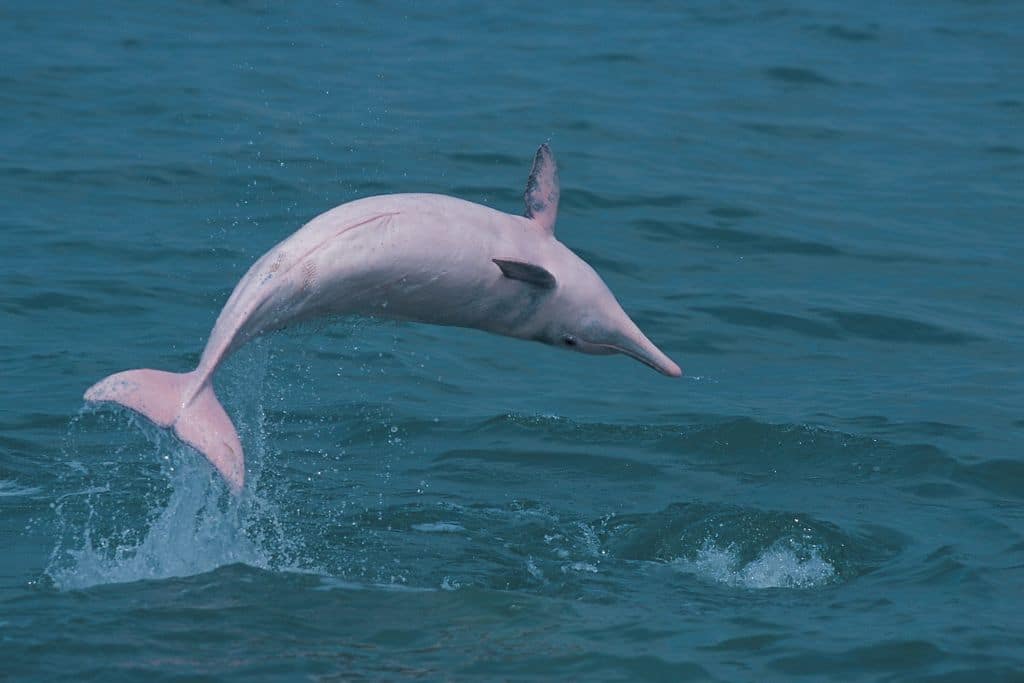Hazards facing the local dolphin population have one common feature – they are all consequences of human activity. And in Hong Kong, many of them converge in the waters off Lantau – historically the stomping grounds of these marine mammals.
If Hong Kong had a charismatic megafauna, it would be the Chinese white dolphin. These playful marine mammals were the mascot of the city’s Handover from British to Chinese rule – their smiling faces a welcome distraction from collective existential crisis – and have been the focus of concerted conservation efforts for more than two decades.
But despite those efforts, the existential crisis is now theirs: Chinese white dolphin abundance has fallen in Hong Kong waters by almost 80 per cent over the past 18 years, according to Agricultural, Fisheries and Conservation Department (AFCD) data.
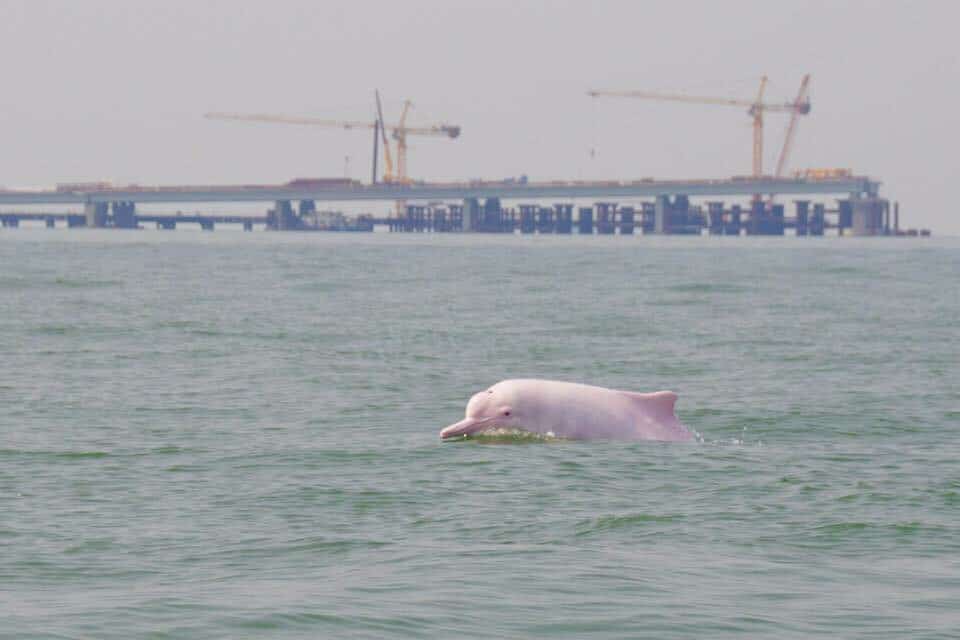
A Chinese white dolphin near the Hong Kong-Zhuhau-Macao Bridge while it was under construction. File Photo: WWF.
Ignorant of maritime borders, Hong Kong’s dolphins are part of a wider Pearl River Delta population of around 2,000 – thought to be the largest group of Chinese white dolphins left in the world. This offers little cause for celebration; Sousa chinensis is considered “vulnerable” on the International Union for Conservation of Nature’s Red List of Threatened Species, meaning that it is “considered to be facing a high risk of extinction in the wild.”
“The situation is critical,” Doris Woo, the cetacean conservation project manager at WWF-Hong Kong told HKFP. “They have already reached their minimum viable population size,” Woo said. “If their numbers drop below 2,000, it will be very hard for them to go up again.”
The animals – also known as Indo-Pacific humpback dolphins, or pink dolphins for the blush appearance they acquire as adults – live in shallow coastal areas across Asia; according to WWF they were first recorded in local waters in the 1600s.
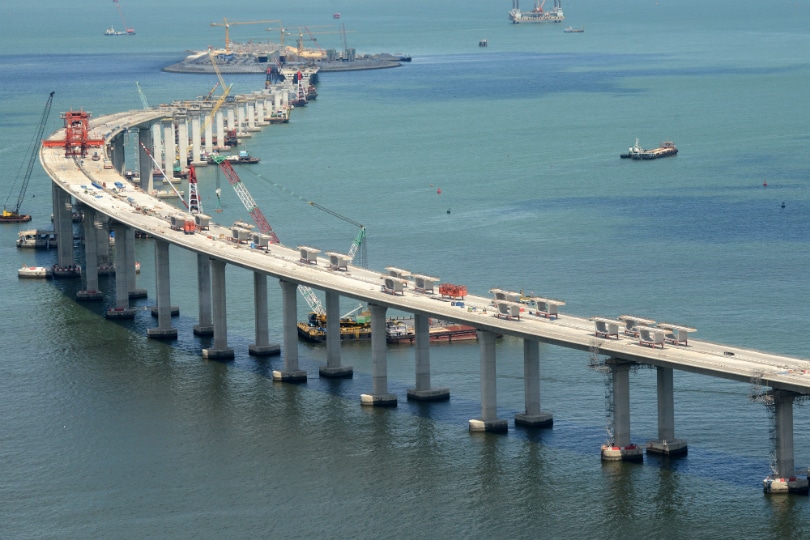
Construction of the Hong Kong-Zhuhai-Macao Bridge. File Photo: GovHK.
Today, though, the NGO has identified seven critical threats in those waters: habitat loss and degradation from development and construction; fewer fish to feed on because of illegal fishing and unsustainable fishing practices; underwater noise disturbance from construction and boat traffic; the risk of being struck by marine vessels; toxins and pollutants from industrial and agricultural run-off; drowning after becoming entangled in fishing nets; and rising sea levels, which in turn lead to greater loss of habitat.
These hazards have one common feature – they are all consequences of human activity. And in Hong Kong, many of them converge in the waters off Lantau – historically the stomping grounds of these marine mammals, at least until recent development projects redrew the map.
Hostile Habitat
“As Hong Kong marine construction activities have increased in the last two decades, Hong Kong has become a stressful habitat for dolphins to live in,” Lindsay Porter, a marine biologist and senior research scientist at research organisation SEAMAR, told HKFP.
As a result, dolphins either move away, outside of the zone covered by long-term census monitoring, or “anthropogenic activities cause ‘un-natural’ mortality and suppress reproduction,” Porter said, adding that both factors could be at play.
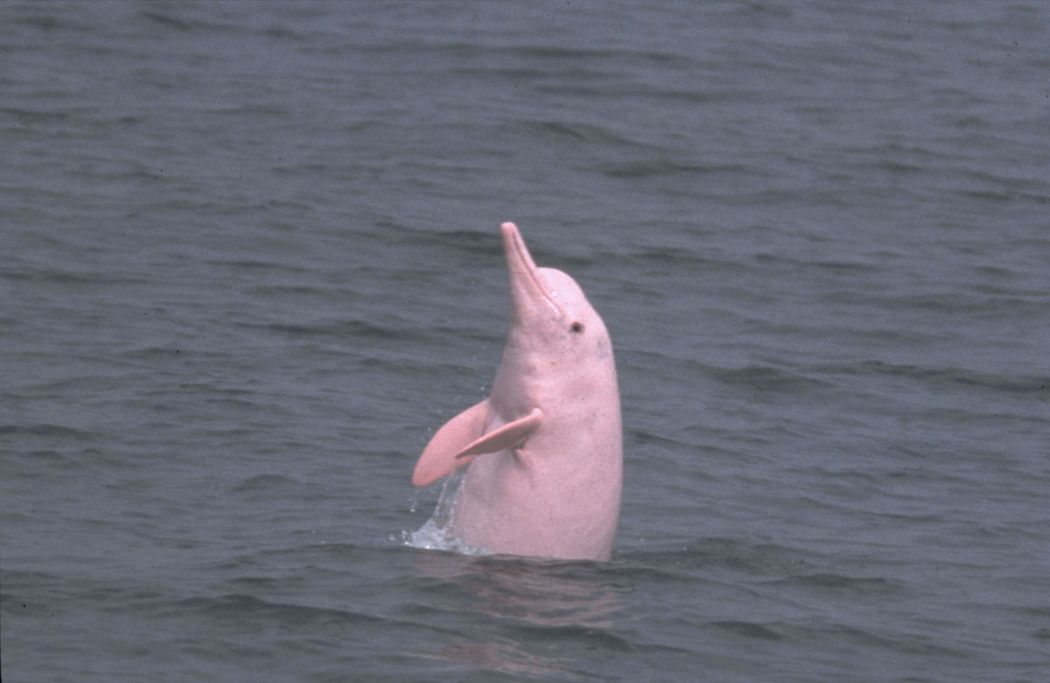
A Chinese white dolphin. File photo: GovHK.
“As has been stated by various independent sources since the early 1990s… the population of dolphins that resides within the Pearl River Estuary is in decline,” said Porter, explaining that “what we see in Hong Kong is the easternmost edge of that population.”
The long-term census monitoring mentioned by Porter has been an AFCD initiative for more than two decades, observing and collecting data on Hong Kong’s dolphins and Indo-Pacific finless porpoises according to the same metrics since 2003.
Measured in abundance – a population estimate reached after analysing data collected by the Hong Kong Cetacean Research Project (HKCRP), which conducts the monitoring for the AFCD – there were just 40 dolphins in Hong Kong in 2021. That marks an increase from 2018, when the estimate was 32, a record low, but a huge drop from 188 dolphins in 2003.
The AFCD acknowledged that the decline was linked to government-led development schemes. “A drop in CWD abundance was noted in recent years and the drop coincided with major infrastructural projects such as the Third Runway System project,” a spokesperson from the department told HKFP.
“Reclamation and marine construction works would inevitably bring about ecological impact and disturbance to nearby waters and affect marine species such as CWDs. One of the methods for CWDs to cope with the negative effects posed by these infrastructural projects is to avoid using the affected area temporarily,” the AFCD spokesperson said.
Coastal construction projects destroy habitats and disrupt the availability of prey. They are also incredibly noisy. “During construction activities, the underwater noise levels are intense,” Porter said. Loud subaquatic conditions can hamper dolphins’ ability to communicate, navigate, locate prey and avoid danger.
At worst, “extremely loud noises can kill dolphins,” Porter said.
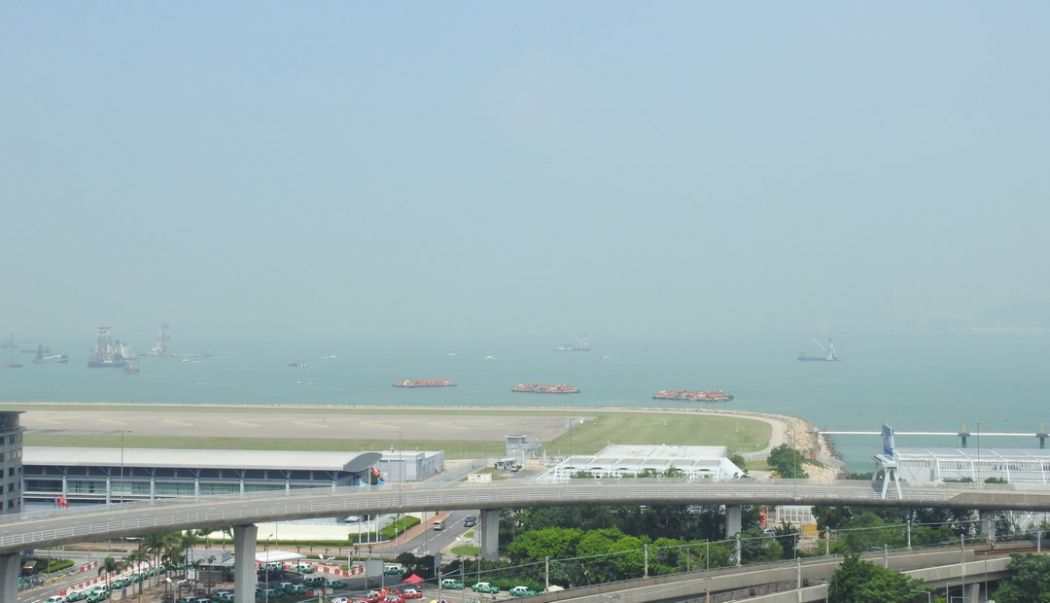
The reclamation site of Hong Kong airport’s third runway project. Photo: Supplied.
“Some construction projects last for 10 years or more, so the dolphins are subject to intense noise at almost every moment of the day and night if the construction site operates 24/7, as many do,” she added.
You might also like: Why Endangered Dolphins Are On the Rise
‘No Apparent Signs of Recovery’
Indeed, the most recent monitoring report, submitted to the AFCD in July, paints a damning picture. “In the past decade, dolphin occurrence in the North Lantau region has greatly diminished… with no apparent signs of recovery owing to the consecutive implementation of major reclamation and coastal development works,” it notes.
“Continuous and alarming declines in dolphin usage were observed within the Brothers Marine Park and the Sha Chau and Lung Kwu Chau Marine Park.”
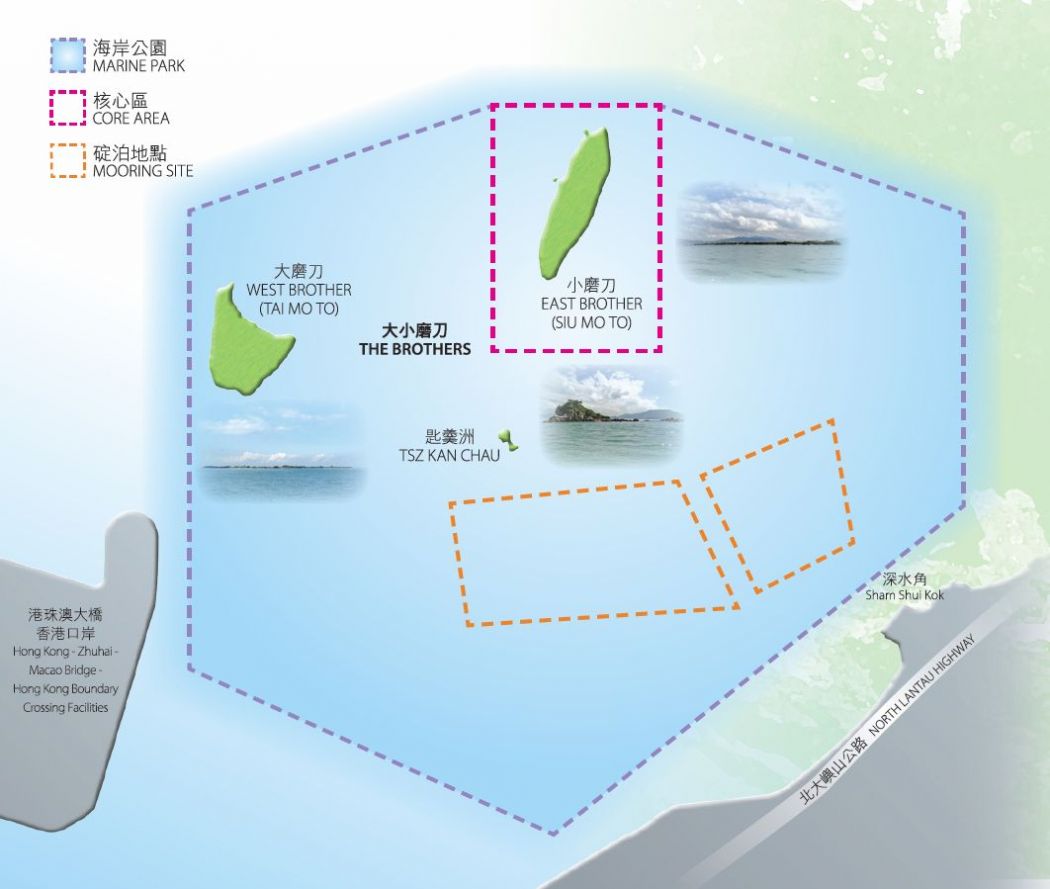
The Brothers Marine Park. Photo: GovHK.
The former was designated off the coast of north Lantau in 2016 in an attempt to atone for permanent habitat loss caused by construction of the city’s section of the Hong Kong-Zhuhai-Macao Bridge (HZMB), as set out in its Environmental Impact Assessment (EIA) report.
When the Brothers Marine Park became official, an AFCD spokesperson called it “an important Chinese white dolphin habitat” – and indeed it had been. However, HKCRP data showed dolphin usage of the area experienced “a dramatic decline” since 2011 – the year construction of the bridge began. Between 2015 and 2021, HKCRP recorded “zero dolphin density” in the marine park.
“Although dolphin usage was expected to recover after the completion of most marine works associated with HZMB construction and the establishment of the [Brothers Marine Park] in December 2016, their occurrence around the Brothers Islands remains extremely rare in recent years,” HKCRP said.
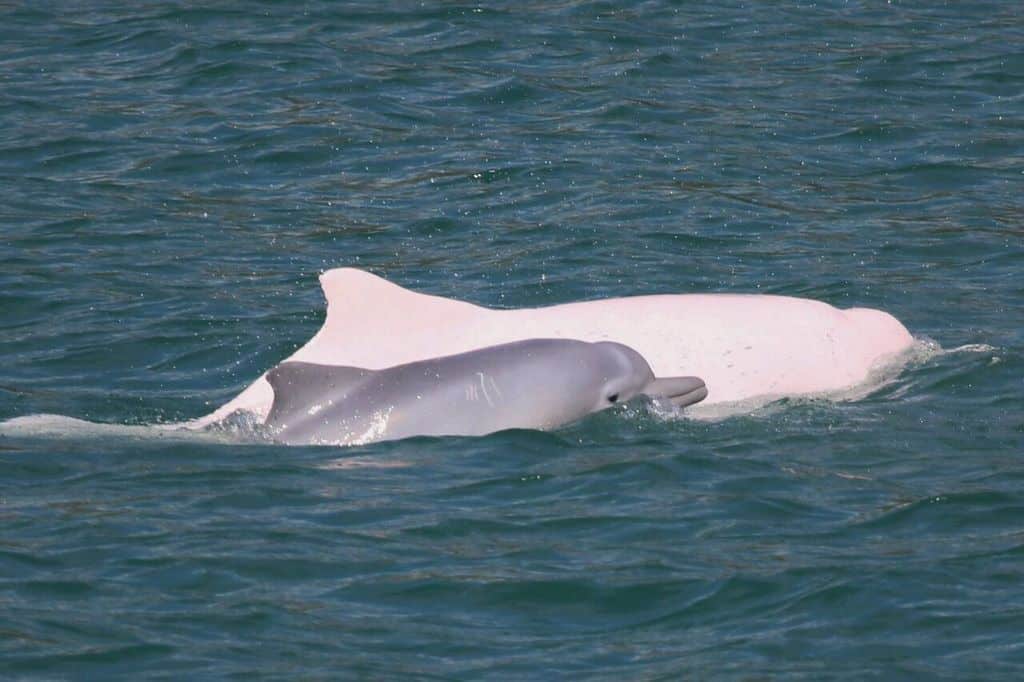
Chinese white dolphin and calf. Photo: Hong Kong Dolphin Conservation Society.
As for Sha Chau and Lung Kwu Chau Marine Park, also in the waters north of Lantau, HKCRP said there has been an “alarming decline” in dolphin usage since 2013, which “raises serious concerns because this area has long been considered important dolphin habitat in Hong Kong.”
Marine Park Mitigation
Data collected from acoustic monitoring in the two marine parks in north Lantau waters underlined what HKCRP researchers had observed. “This suggests that the continuing construction activities in waters adjacent to the marine parks (e.g. the 3RS project and the Tung Chung New Town Development reclamation project) are having noticeable impacts on dolphin occurrence within the protected waters… even over a fairly short period of time,” the monitoring report read.

The third runway began operation on July 8, 2022. Photo: Airport Authority Hong Kong.
“3RS” is shorthand for the third runway at Hong Kong International Airport, part of a controversial HK$141.5 billion project that opened in July as the city’s aviation industry was languishing under strict Covid-19 travel restrictions. The additional runway angered environmental advocates, who believed the EIA failed to fully evaluate the impact of the project.
Two activists took their grievances to the High Court to try and prevent the Airport Authority from breaking ground. Their legal challenge was rejected and construction began in 2016.
Included in the conditions of the Environmental Permit for the third runway was the designation of another marine park, “as compensation for the seabed habitat and open waters habitat loss associated with the land formation for the 3RS Project.”
This one would measure 2,400 hectares and “would protect and conserve the marine environment around the HKIA from various anthropogenic threats such as sewage discharge, seabed dredging, dumping, coastal reclamation and destructive fishing.”

Conservationists Doris Woo (left) and Viena Mak. Photo: Kelly Ho/HKFP.
Currently still in the proposal stage, the North Lantau Marine Park, as it is expected to be called, would connect Sha Chau and Lung Kwu Chau Marine Park and Brothers Marine Park. Where this park will differ from existing protected areas is that AFCD will establish “SMART goals” – specific, measurable, achievable, relevant, and time-bound objectives that will help assess how well Chinese white dolphin conservation is going.
“This is a very good approach to manage the effectiveness of all the protected areas,” WWF’s Woo said. Such parameters should help identify any “change in the dolphin’s abundance, density and how they use the area after the designation of the protected area.”
But before the North Lantau Marine Park can be designated, the construction of a 45-kilometre subsea gas pipeline connecting Black Point Power Station in Yuen Long with a liquefied natural gas terminal in waters to the east of the Soko Islands, south of Lantau, must be completed. It will run “parallel and within” the western boundary of the proposed marine park and pass to the west of the South Lantau Marine Park, according to the EIA.
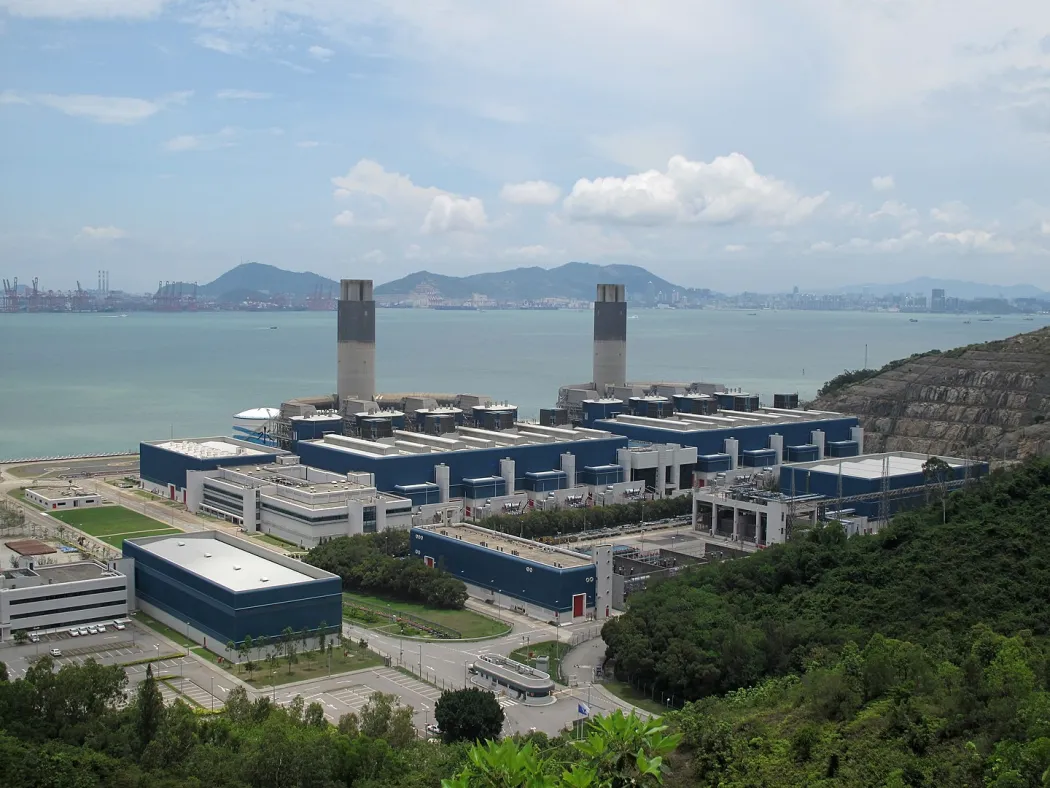
Black Point Power Station in Yuen Long, in Hong Kong. File photo: Minghong/Wikicommons.
The LNG terminal is being constructed as part of Hong Kong’s efforts to reduce carbon reliance and safeguard long-term energy security. In August, CLP Power told investors that while the post-trenching work for the pipeline was nearly finished, the “laying of rock protection works continues.” The terminal is expected to enter commercial operation next year.
You might also like: The Importance of Land Reclamation in Hong Kong and its Impacts
Population Migration
Responding to a question from lawmaker Kwok Wai-Keung last month, the Secretary for Environment and Ecology Tse Chin-wan said that as “major infrastructure projects near Lantau waters progressively come to completion, there is the possibility that the dolphin number would gradually increase in the next few years and occurrence would become more frequent” – tacit acknowledgement that these projects played a role in keeping the cetaceans away.
Tse was referring specifically to the waters of the recently established South Lantau Marine Park, an area of 2,067 hectares around the Soko Islands that was designated in June as compensation for yet another construction project: the Integrated Waste Management Facilities – essentially a giant incinerator – at Shek Kwu Chau.
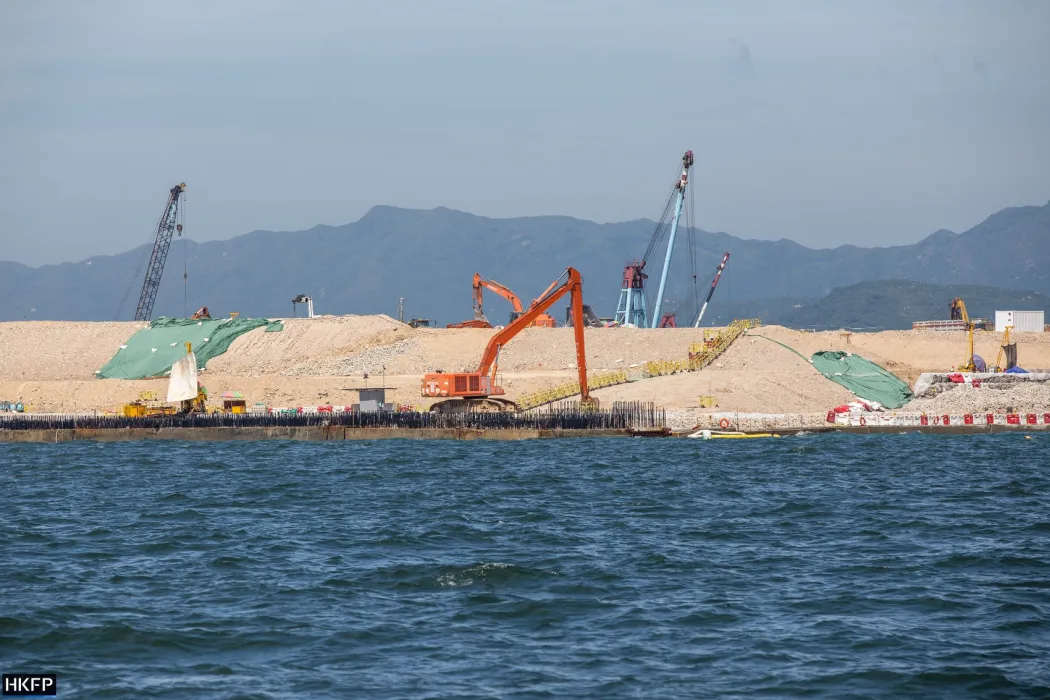
Construction work on an artificial island near Shek Kwu Chau in 2021. Photo: Kelly Ho/HKFP.
Historically an important habitat for finless porpoises and, to a lesser extent, Chinese white dolphins, HKCRP noted “low to moderate dolphin densities” in central south Lantau waters around Shek Kwu Chau, according to its most recent report, which was completed before the marine park was established.
WWF and HKCRP have raised the urgent need to protect the waters around south and southwest Lantau, noting the migration of dolphin populations since north Lantau waters essentially became a massive and ongoing construction site. Even with mitigation measures beyond marine parks written into EIAs for each project, the hope that dolphins might quickly return to a recently hostile environment appears to be little more than a fantasy.
“Unfortunately, we still haven’t seen any sign of recovery in numbers in impacted regions, especially in north Lantau, where there was the bridge, the artificial island, the third runway, and also reclamation areas close to Tung Chung,” Woo said.
‘Disturbed for Over a Decade’
Porter noted the importance of marine parks to Chinese white dolphin conservation, calling habitat protection “the cornerstone of every management plan for coastal marine species that have a restricted range, strong societal structure and localised prey resources.” However, marine parks alone will not bring the cetaceans back.
“Once a marine development is completed, there is an opportunity for the habitat to stabilise, stressors are removed and dolphins and their prey may settle into the altered habitat. The issue in Hong Kong over the last few years is that mega projects have overlapped in both area and timing and the dolphins’ habitat has been in a disturbed state for over a decade,” Porter said.
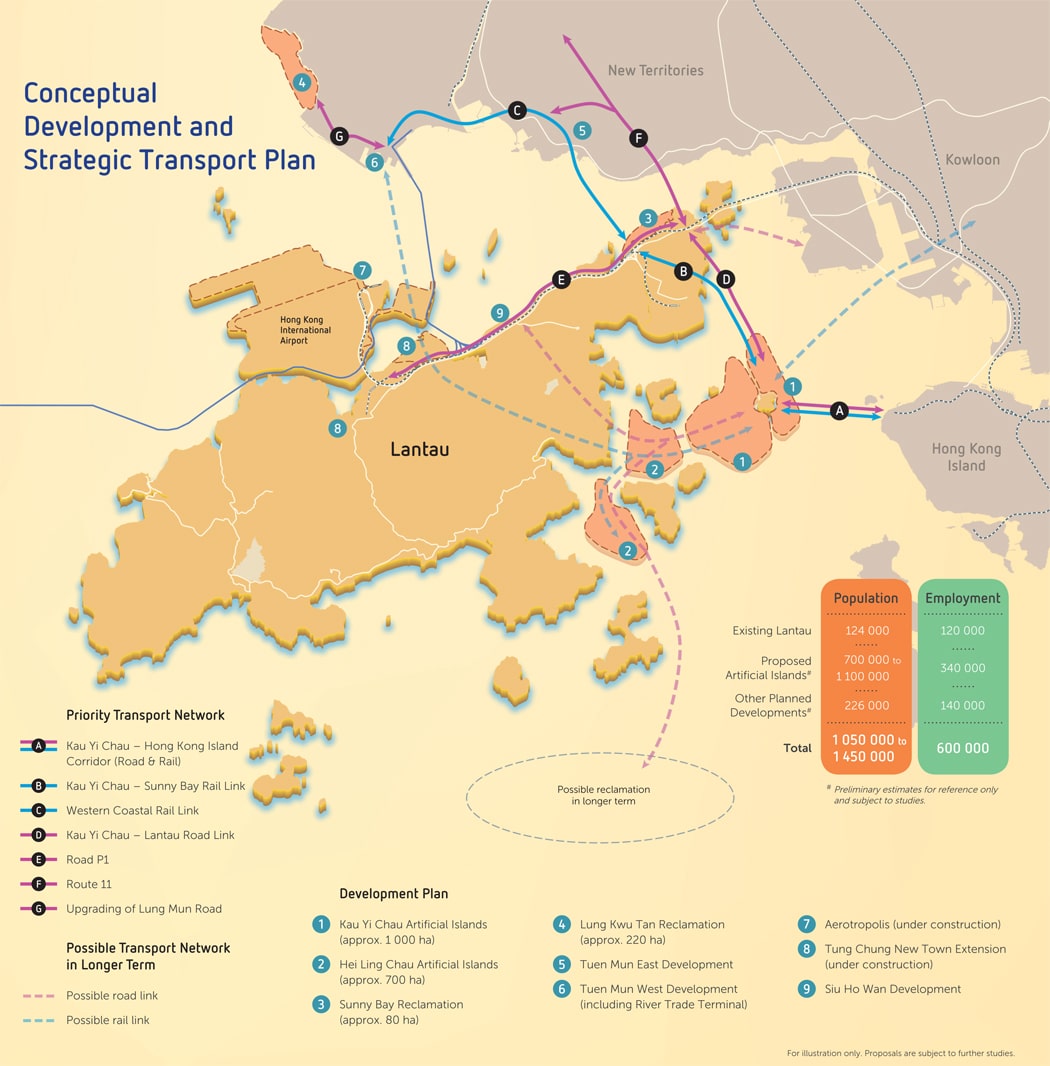
Lantau Tomorrow Vision. Photo: GovHK.
Porter also took issue with Tse’s suggestion that such construction projects were coming to an end. In his inaugural Policy Address delivered in October, Chief Executive John Lee signalled his administration’s commitment to perhaps Hong Kong’s biggest development plan to date – Lantau Tomorrow Vision. This centres around massive land reclamation to build a series of artificial islands in Lantau’s eastern waters, which, Woo of WWF said would “definitely mean a loss of habitat for finless porpoise.”
Additionally, Woo said that reclamation “will result in water pollution and noise pollution,” which cannot be effectively contained within the footprint of the reclaimed area.
“Even outside Hong Kong there are a lot of large-scale works happening, such as the Shenzhen-Zhongshan Bridge,” Woo added. “The mainland side is equally busy.”
Porter agreed. “We are very far away from there being a cessation of projects in the waters that dolphin and porpoise rely on,” she said.
Featured image: Flickr
This article was originally published on Hong Kong Free Press, written by Mercedes Hutton, and is republished here as part of an editorial partnership with Earth.Org.








